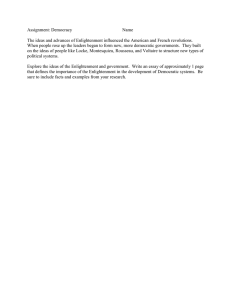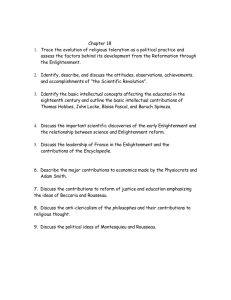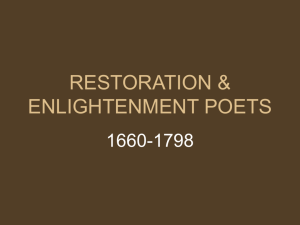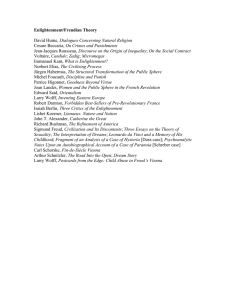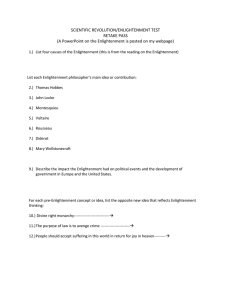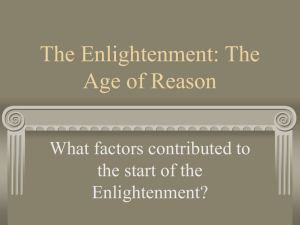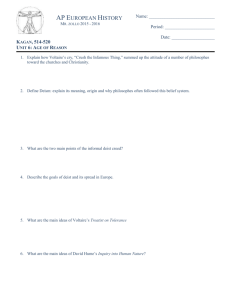DEPARTMENT OF HISTORY MODULE HANDBOOK SCIENCE, MEDICINE AND NATURE IN THE FRENCH ENLIGHTENMENT
advertisement
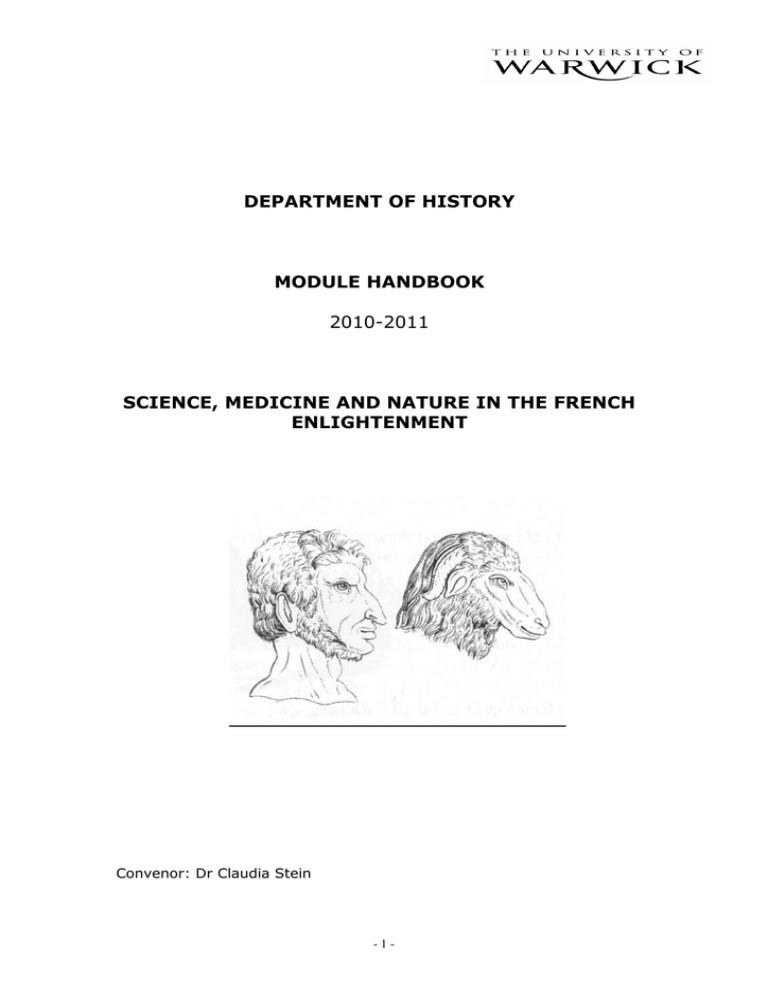
DEPARTMENT OF HISTORY MODULE HANDBOOK 2010-2011 SCIENCE, MEDICINE AND NATURE IN THE FRENCH ENLIGHTENMENT Convenor: Dr Claudia Stein -1- Table of Contents Context of Module 3 Module Aims 3 Intended Learning Outcomes 3 Syllabus Week 1: Introduction 4 Week 2: What is Enlightenment? 4 Week 3: The 'Birth' of the Clinic 4 Week 4: Public Science: Science and Spectacle 6 Week 5: Scientific Facts and Human Imagination 8 Week 6: Reading Week Week 7: Sentimental Science: the Case of Mesmerism 9 Week 8: Truth to Nature or Objectivity: Science and Visual Evidence 11 Week 9: Inventing Human Nature 13 Week 10: Final Discussion: Enlightenment and Postmodernity 15 Illustrative Bibliography 15 -2- Context of Module This module may be taken by students on the MA in the Social History of Medicine, on the MA in Eighteenth-Century Studies, on the MA in Religious and Social History, or any taught master's students within and outside the History Department. Module Aims This module will allow students to explore ideas and practices of science and medicine in Britain and western Europe from c.1450 to c.1800, a period which covers the socalled 'Scientific Revolution'. A particular concern will be to set these ideas and practices in their contexts - social, cultural, religious, political, etc. In addition, the impact of Europe's encounter with the wider world will also be examined. Intended Learning Outcomes The development of seminar participation and presentation skills The ability to recognise and engage with the historiography of medicine, science and natural history To provide experience of independent preparation and writing of a 5,000 word essay, including the framing of a question, the demonstration of critical engagement with recent scholarship and effective use of primary sources where appropriate, independent evaluation of contrasting evidence and interpretations, the formulation of conclusions and the creation of an extensive and specialist bibliography and scholarly apparatus The ability to build on themes and skills related to the module to develop a dissertation topic. -3- Week 1: Introduction Readings: Outram, Dorinda, The Enlightenment 2nd ed. (Cambridge, 2005), chapter 1, pp. 1-10; chapter 4: pp. 93-108 Porter, Roy, The Greatest Benefit to Mankind (New York, 1997), chapter 10, pp. 245-303 Week 2: What is Enlightenment? Readings: Kant, Emanuel, ‘What is Enlightenment?’ (1782) Adorno, Theodor/Horkheimer, Max, Dialectic of Enlightenment (New York, 1972), chapters on ‘The Concept of Enlightenment’ Foucault, Michel, ‘What is Enlightenment?, in The Essential Foucault Reader, ed. by Paul Rabinow and Nikolas Rose (London, 1994), pp.43-57 Week 3: The ‘Birth’ of the Clinic Readings: Foucault, Michel, Birth of the Clinic, chapter 4 and 5, pp. 54-87. Jewson, N., ‘The Disappearance of the Sick Man from Medical Cosmology: 17701870’, Sociology 10 (1976), pp. 225-244. Risse, Guenter, Mending Bodies – Saving Souls: The History of the Hospital (Oxford, 1999), pp. 289-331. Further Readings: Ackerknecht, Erwin, Medicine at the Paris Hospital, 1794-1848 (Baltimore, 1967). Armstrong, David, ‘Bodies of Knowledge/Knowledge of Bodies’, Colin Jones/Roy Porter, Reassessing Foucault: Power, Medicine and the Body (London, 1994) Brockliss, Laurence, ‘Medical Reforms, the Enlightenment, and Physician-Power in the late Eighteenth Century’, in Roy Porter (ed.), Medicine in the Enlightenment (Amsterdam, 1995) Brockliss, Laurence/Jones, Colin, The Medical World of Early Modern France (Oxford, 1997) -4- Bynum, William F., ‘Nosology’, in Companion Encylopedia of the History of Medicine, ed. by W.F. Bynum and Roy Porter, vol. 1 (London, 1993), pp. 335-356 Frangos, E., From Housing the Poor to Healing the Sick: The Changing Institutions of Paris under the Old Regime and the Revolution (Madison, 1997) Hanaway, Caroline, ‘The Societe Royale de Medecine and Epidemics in the Ancient Regime,’ Bulletin of the History of Medicine 46 (1972), pp. 257-273. Heilbron, J., ‘The Measure of Enlightenment’, in The Quantifying Spirit in the 18th Century, ed. By Tore Frangsmyr, J.H. Heilbron, and Robin E. Rider (Berkeley et al., 1990), pp. 207-242 Lawrence, Susan C., Charitable Knowledge: Hospital Pupils and Practitioners in Eighteenth-Century London (Cambridge, 1996) Ramsey, Mathew, Professional and Popular Medicine in France, 1770-1830 (Cambridge, 1988) Riley, James, The Eighteenth Century Campaign to Avoid Disease (New York, 1987). Risse, Guenter, Hospital Life in Enlightenment Scotland: Care and Teaching at the Royal Infirmary of Edinburgh (Cambridge, 1986) Risse, Guenter, Medicine in the Age of Enlightenment (Cambridge, 1992) Troehler, Ulrich, ‘Quantifiying Experience and Beating Biases: A New Culture in Eighteenth Century British Clinical Medicine’, in Body Counts: Medical Quantification in Historical & Sociological Perspective, ed. by Jorland, Gerald/Annick Opinal/George Weisz (eds.), (Montreal, 2005) Wilson, Lindsay B., Women and Medicine in the French Enlightenment: The Debate Over “Maladies des Femmes” (Baltimore, 1993) -5- Week 4: Public Science: Science and Spectacle Readings: Cooter, Roger/Pumfrey, Stephen, ‘Separate Spheres and Public Places: Reflections on the History of Science Popularization and Science in Popular Culture’, History of Science 32 (1994): 237-267 Kim, Mi Gyung, ‘’Public’ Science: Hydrogen Balloons and Lavoisier’s Decomposition of Water’ 63, 3 (2006): 291-318 Langins, J., ‘Hydrogen Production for Ballooning During the French Revolution – an example of Chemical Progress Development’, Annals of Science, pp. 531-558 Further Readings: Bertucci, Paola/Guiliano Pancaldi (eds.), Electric Bodies. Episode in the History of Medical Electricity (Bologna, 2001), pp. 69-90. Benedict, Maria M., Curiosity: A Cultural History of Early Modern Curiosity (Chicago, 2001), Chapter: Performing Curiosity Broman, Thomas, ‘The Habermasian Public Sphere and ‘Science’ in the Enlightenment’, in History of Science 36 (1998): 123-149. Daston, Lorraine, ‘The Ideal and the Reality of the Republic of Letters in the Enlightenment’, Science in Context 4,2 (1991): 367-386. Tetter Dobbs, Betty Jo/Jacobs, Margaret C., ‘Newton and the Culture of Newtonisim (Atlantic Hights, 1995), chapter 2 Gascoigne, J., Joseph Banks and the English Enlightenment: Useful Knowledge and Polite Culture (Cambridge, 1994). Golinski, Jan, Science as Public Culture: Chemistry and Enlightenment in Britain, 1760-1820 (Cambridge, 1992). Gillispie, Charles, The Montgolfier Brother and the Invention of Aviation, 17831784 (Princeton, 1983) Hahn, Roger, The Anatomy of a Scientific Institution: The Paris Academy of Sciences, 166-1803 (Berkely, University of California Press, 1971). Heilbron, J.L., Elictricity in the Seventeenth and eighteenth Centuries (New York, 1999) Jacob, Margret C., Scientific Culture and the Making of the Industrial West (New York, 1997) -6- Landes, Joan, Women and the Public Sphere in the Age of Revolution (Ithaca, 1987). MacClellan, James E., Science Reorganised: Scientific Societies in the 18th Century (New York, 1980). Lynn, Michael, ‘Enlightenment and the Public Sphere: The Musé de Monsieur and Scientific Culture in Late Eighteenth-Century Paris’, in Eighteenth Century Studies 32 (1999): 463-476. Hochadel, Oliver, Öffentliche Wissenschaft. Elektrizität in der deutschen Aufklärung (Göttingen, 2003) Ibid., ‘The Sale of Shocks and Sparks: Itinerant Electricians and the German Enlightenment’, in Science and Spectacle in the European Enlightenment, ed. by Bernadette Bensaude-Vincent and Christine Blondel (Aldershot, 2008), pp. 89101. Riskin, Jessica, ‘Amusing Physics’, in Science and Spectacle in the European Enlightenment, ed. by Bernadette Bensaude-Vincent and Christine Blondel (Aldershot, 2008), pp. 43-63 Schaffer, Simon, ‘Natural Philosophy and Public Spectacle in the Eighteenth Century’, in History of Science 21 (1983): 1-43. (older but still very important) Ibid., ‘The Consuming Flame: Electrical Showmen and Public Spectacle in Eighteenth-Century England’, in Consumption and the World of Gods, ed. by John Brewer and Roy Porter (London, 1993) (important) Simon, Jonathan, ‘Honor Fragonard, Anatomical Virtuoso’, in Science and Spectacle in the European Enlightenment, ed. by Bernadette Bensaude-Vincent and Christine Blondel (Aldershot, Ashgate, 2008), pp. 141-158. Sutton, G.V., Science for a Polite Society: Gender, Culture and the Demonstration of Enlightenment (Philadelphia, 1995) Wood, Paul, ‘Science, the Universities, and the Public Sphere in EighteenthCentury Scotland’, History of Universities 14 (1994): 99-135. Yeo, Richard, Sciene in the Public Sphere: Natural Knowledge in British Culture, 1800-1860 (Aldershot, 2001). -7- Week 5: Scientific Facts and Human Imagination Readings: Daston, Lorraine, ‘Fear and Loathing of the Imagination in Science’, Daedalus 127, 10 (1998): 73-95 Goldstein, Jan, The Post Revolutionary Self: Politics and Psyche in France, 17501850 part 1, chapter 1: The Perils of Imagination at the End of the Old Regime, pp. 27-59 Shapiro, Barbara, Probability and Certainty in Seventeenth-Century England: A Study of the Relationship Between Natural Science, Religion, History, Law and Literature (Princeton, 1983), chapter 2: Natural Philosophy and Experimental Science, pp. 15-73. Shapin, Steven, A Social History of Truth (Chicago, 1994), chapter 5: Epistemological Decorum: The Practical Management of Factual Testimony, pp. 193-242 Further Readings: Brewer, John, Pleasures of the Imagination: English Culture in the Eighteenth Century (Chicago, 1997) Daston, Lorraine, ‘Baconian Facts, Academic Civility, and the Prehistory of Objectivity’, Annals of Scholarship 8, 3-4 (1991): 337-64 Ibid., Classical Probability in the Enlightenment (Princeton, 1988) Ibid., ‘Enlightenment and Fear’, in What’s Left of Enlightenment? A Postmodern Question, ed. by Keith Michael Baker and Peter Hanns Reill (Stanford, 2001), pp Ibid., ‘Science and the Discovery of the Imagination in Enlightened England’ Eighteenth-Century Studies 3 (1969): 108-35 Johns, Adrian, The physiology of reading and the Anatomy of Enthusiasm, in Religio Medico: Medicine and Religion in Seventeenth-Century England, ed. by Ole Peter Grell and Andrew Cunningham (Aldershot, 1996), pp. 136-170. Shapin, Steven/Schaffer, Simon, Leviathan and the Air-Pump (Chicago, 1985) Barbara J. Shapiro, A Culture of Fact: England, 1550-1720 Fischer-Homberger, Ester, On the Medical History of the Doctrine of Imagination Psychological Medicine 9 (1979): 619-628 -8- Week 7: Sentimental Science: the Case of Mesmerism Readings: Darnton, Robert, Mesmerism and the End of Enlightenment in France (Cambridge, MA, 1968), chapter 2: The Mesmerist Movement, pp. 47-81 Riskin, Jessica, Science in the Age of Sensibility: The Sentimental Empiricists of the French Enlightenment, Introduction and chapter 6: Mesmerism Investigation and the Crisis of Sensibilist Science Vila, Anne C., Enlightenment and Pathology: Sensibility in the Literature and Medicine of Eighteenth-Century France (1998), part 1: The making of the Sensible Body, chapter 1: Constructing a Vital Property Further Readings (see also literature under Science and Spectacle): Baasner, Frank, ‘The Changing Meaning of Sensibilité’, Studies in EighteenthCentury Culture 15 (1986): 77-96 Barker-Benfield, G. F, The Cultures of Sensibility: Sex and Society in EighteenthCentury Britain (Chicago, 1992) Figlio, Karl, ‘Theories of Perception and the Physiology of Mind in the Late Eighteenth Century’ History of Science 13 (1975): 177-212 Gillispie, Charles, Science and Polity at the End of the Old Regime (Princeton, 1980) Haigh, Elizabeth L., ‘Vitalism, the Soul, and Sensibility: The Physiology of Théophile de Bordeu’, Journal of the History of Medicine and Allied Sciences 31 (1976): 30-41 Midelfort, Eric, Exorcism and Enlightenment: Johann Joseph Gassner and the Demons of Eighteenth-Century Germany (New Haven, 2005) Mullan, John Sentiment and Sociability: The Language of Feeling in the Eighteenth Century (Oxford, 1988) Todd, Janet, Sensibility: An Introduction (London, 1986) Rousseau, G.S., ‘Discourses on the Nerves’, in Literature and Science as Modes of Expression,ed. by Frederick Amrine (Dordrecht, 1989), pp. 29-60 Ibid., ‘Nerves, Spirtis, and Fibres :Towards Defining the Origin of Sensibility’ Studies in the Eighteenth Century III: Papers Presented at the Third David Nichols Smith Seminar Toronto, 1976) -9- Ibid., (ed.), The Language of Psyche: Mind and Body in Enlightenment Thought (Berkely, 1990) Ibid., ‘Sensibility Reconsidered’, Medical History 39 (1995): 375-77 Sutton, Geoffrey, Science for a Polite Society: Gender, Culture, and the Demonstration of Enlightenment (Boulder, 1995) - 10 - Week 8: Truth to Nature or Objectivity: Science and Visual Evidence Readings: Daston, Lorraine/Galison, Peter, Objectivity (New York, 2007), Chapter 1: Epistemologies of the Eye, and Chapter 2: Truth-to-Nature Extra: Look up the terms ‘objectivity’ and ‘subjectivity’ in dictionaries of your choice! Further Readings: Alpers, Svetlana, The Art of Describing: Dutch Art in the Seventeenth-Century (Chicago, 1983) Brain, Baigrie (ed.), Picturing Knowledge: Historical and Philosophical Problems Concerning the Use of Art in Science (Toronto, 1996). Bredekamp, Horst, The Lure of Antiquity and the Cult of the Machine: The Kunstkammer und die Evolution of Nature, Art and Technology (Princeton, 1995) Clarke, Bruce/Henderson Dalrymple, Linda, From Engery to Information: Representation in Science and Technology, Art and Literature (Stanford, 2002) Crary, Jonathan, Techniques of the Observer (Cambridge, Mass., 1990). Daston, Lorraine, ‘Nature by Design’, in Picturing Scienc, Producing Art ed. by Caroline Jones and Peter Galison (New York/London, 1998), pp. 232-253 Daston, Lorraine/Park Catharine, Wonders and the Order of Nature, 1150-1750 (New York, 1998) Fleck, Ludwik, Genesis and Development of a Scientific Fact (1935) (Chicago, 1979) (the! classic everybody should have read) Ford, Brian, Images of Science: A History of Scientific Illustration (London, 1992) Jordanova, Ludmilla, ‘Gender, Generation and Science: William Hunter’s Obstetrical Atlas’, in William Hunter and the Eighteenth-Century Medical World, ed. by W.F. Bynum and Roy Porter (Cambridge: Cambridge University Press, 1985), pp. 385-412 Kemp, Martin, ‘Looking and Learning in some Anatomical Illustrations from the Renaissance and the Eighteenth Century’, W. Bynum and Roy Porter (eds.), Medicine and the Five Senses (Cambridge, 1993), pp. 85-121 Ibid., Seen/Unseen: Art and Science, and Intuition from Leonardo to the Hubble Telescope (Oxford, 2006) - 11 - Latour, Bruno, ‘Visualization and Cognition: Thinking with Eyes and Hands’, Knowledge and Society 6 (1986): pp. 1-40 Park, Katharine, ‘Impressed Images: Reproducing Wonder’, in Picturing Science, Producing Art, ed. by Caroline Jones and Peter Galison (New York/London 1998), pp. 254-71 Pomian, Krzytof, ‘Vision and Cognition’, in Picturing Science, Producing Art, ed. by Caroline Jones and Peter Galison (New York/London, 1998), pp. 211-229 Putscher, Marielene, Geschichte der Medizinischen Abbildung, 2 vols (Munich, 1972) Rudwick, Martin, ‘The Emergence of a Visual Language for the Geological Science 1760-1840’, History of Science XIV (1976), pp. 149-195 Shea, William, ‘The Rhetoric of Experiments and Scientific Illustrations in the Enlightenment’, in ibid., Science and the Visual Images in the Englightenment (2000), pp. 39-56 Shea, William (ed.), Science and the Visual Images in the Englightenment (2000) Stafford, Barbara, Artful Science: Enlightenment Entertainment and the Eclipse of Visual Education (Cambridge, Mass., 1994) Ibid., Body Criticism: Imaging the Unseen in the Enlightenment Art and Medicine (Cambridge, Mass., 1991), pp. 47-120 Ibid., ‘Images of Ambiguity: Eighteenth-Century Microscopy and the either/or’, in Vision of Empire: Voyages, Botanty, and Representation of Nature, ed. by David Philip Miller and Peter Hanns Reill (Cambridge, 1996), pp. 230-257 - 12 - Week 9: Inventing Human Nature Readings: Wokler, Robert, Anthropology and Conjectural History in the Enlightenment’, in Inventing Human Science: Eighteenth-Century Domains, ed. by Christopher Fox, Roy Porter, and Robert Wokler, pp. 31-52 Porter, Roy, ‘Medical Science and the Enlightenment’, in Inventing Human Science: Eighteenth-Century Domains, ed. by Christopher Fox, Roy Porter, and Robert Wokler, pp. 53-87 Smith, Roger, ‘The Language of Human Nature’, in Inventing Human Science: Eighteenth-Century Domains, ed. by Christopher Fox, Roy Porter, and Robert Wokler, pp. 88-111 Jordanova, Ludmilla, ‘Sex and Gender’, in Inventing Human Science: EighteenthCentury Domains, ed. by Christopher Fox, Roy Porter, and Robert Wokler, pp. 152-183 Further Readings: Blanckaert, Claude, ‘Buffon and the Natural History of Man: Writing History and the ‘Foundational Myth’ of Anthropology’, History of the Human Sciences 6 (1993): 13-50 Carrithers, David, ‘The Enlightenment Science of Society’, in Inventing Human Sciences: Eighteenth-Century Domains, ed. by Christopher Fox, Roy Porter and Robert Wokler (Berkeley, 1995), pp. 232-270. Duden, Barbara, The Women Beneath the Skin: A Doctor’s Patients in Eighteenth Century German Cambridge, 1991) Foucault, Michel, The Order of Things: An Archaeology of Human Sciences (1966) (London, 1970) Figlio, Karl, ‘The Historiography of Scientific Medicine: An Invitation to the Human Sciences’, Comparative Studies in Society and History 19 (1977): 262-286 Fox, Christopher, ‘Defining Eighteenth-Century Psychology: Some Problems and Perspectives’, in Psychology and Literature in the Eighteenth Century, ed. by Christopher Fox (New York, 1987), 1-22 Gutting, Gary, Michel Foucault’s Archaeology of Scientific Reason (Cambridge, 1980) Jones, Peter (ed.), The Science of Man in the Scottish Enlightenment (Edinburgh, 1989) - 13 - Jordanova, Ludmilla, ‘Medical Mediations: Mind, Body, and the Guillotine’, History Workshop 28 (1989) Moravia, S., ‘The Enlightenment and the Science of Man’, History of Science 18 (1980): 247-268 Moscucci, The Science of Woman: Gynaecology and Gender in England, 18001929 (Cambridge, 1990) Laqueur, Thomas, Making Sex: Body and Gender from the Greeks to Freud (Cambridge 1990) Outram, Dorinda, The Body and the French Revolution: Sex, Class, and Political Culture (New Haven, 1989) Porter, Roy/Teich, Mikulas (eds), Enlightenment in National Context (Cambridge, 1981) Schiebinger, Londa, The Mind Has No Sex? Women and the Origin of Modern Science (Cambridge, 1989) Smith, Roger, ‘Does the History of Psychology Have a Subject?’ History of the Human Sciences 1 (1988): 147-177 Tomaselli, Sylvana, ‘Reflections on the History of the Science of Women’, History of Science 29 (1991): 185-205Vidal, Fernando, Psychology in the EighteenthCentury’, History of the Human Sciences 6 (1993): 89-119 Ibid., ‘Psychology in the 18th Century: A View from the Encylopaedias’, History of the Human Sciences 6 (1993): 89-119 Olsen, Richard, ‘The Human Sciences’, in Cambridge History of Science,vol. 4: The Eighteenth Century (Cambridge, 2003), pp. 436-437. - 14 - Week 10: Final Discussion: Enlightenment and Postmodernity Readings: Goodman, Dena, ‘Difference: An Enlightenment Concept’, in What’s Left of Enlightenment: A Postmodern Question, ed. by Keith Michael Baker and Peter Hanns Reill (Stanford, 2001), pp. 129-147. Rorty, Richard, ‘The Continuity Between Enlightenment and ‘Postmodernity’, in What’s Left of Enlightenment: A Postmodern Question, ed. by Keith Michael Baker and Peter Hanns Reill (Stanford, 2001), pp. 19-36 Illustrative Bibliography M.Biagioli, Galileo Courtier (1993) A. Cunningham, The Anatomical Renaissance (1997) A. Cunningham, Religio Medica: Medicine and Religion in 17th-century England (1996) R. Darnton, Mesmerism and the End of the Old Regime (1968) L. Daston & K. Park, Wonders and the Order of Nature, 1150-1750 (2000) P. Dear, Revolutionising the Sciences 1500-1700 (2000) J. Henry, Knowledge is Power (2003) A. Johns, The Nature of the Book (1998) C. Merchant, The Death of Nature: Women, Ecology and the Scientific Revolution (1990) S. Shapin, The Social History of Truth (1994) S. Shapin, The Scientific Revolution (1996) S. Shapin & S. Schaffer, Leviathan and the Air Pump (1985) L. Schiebinger, Nature's Body (1994) L. Schiebinger, Plants and Empire (2004) E. Spary et al. (eds), Cultures of Natural History (1996) - 15 -
